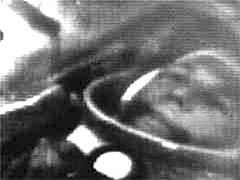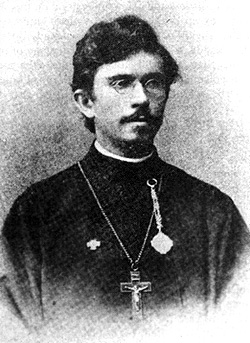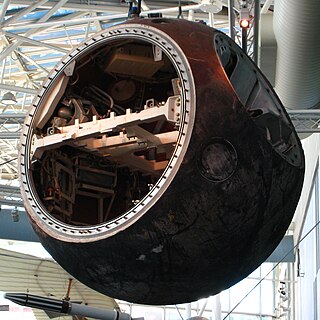
Vostok 1 was the first spaceflight of the Vostok programme and the first human orbital spaceflight in history. The Vostok 3KA space capsule was launched from Baikonur Cosmodrome on 12 April 1961, with Soviet cosmonaut Yuri Gagarin aboard, making him the first human to reach orbital velocity around the Earth and to complete a full orbit around the Earth.

Nikolai Konstantinovich Rerikh, better known as Nicholas Roerich, was a Russian painter, writer, archaeologist, theosophist, philosopher, and public figure. In his youth he was influenced by Russian Symbolism, a movement in Russian society centered on the spiritual. He was interested in hypnosis and other spiritual practices and his paintings are said to have hypnotic expression.
The Treaty on the Protection of Artistic and Scientific Institutions and Historic Monuments or Roerich Pact is an inter-American treaty. The most important idea of the Roerich Pact is the legal recognition that the defense of cultural objects is more important than the use or destruction of that culture for military purposes, and the protection of culture always has precedence over any military necessity.

A number of peace symbols have been used many ways in various cultures and contexts. The dove and olive branch was used symbolically by early Christians and then eventually became a secular peace symbol, popularized by a Dove lithograph by Pablo Picasso after World War II. In the 1950s the "peace sign", as it is known today, was designed by Gerald Holtom as the logo for the British Campaign for Nuclear Disarmament (CND), a group at the forefront of the peace movement in the UK, and adopted by anti-war and counterculture activists in the US and elsewhere. The symbol is a superposition of the semaphore signals for the letters "N" and "D", taken to stand for "nuclear disarmament", while simultaneously acting as a reference to Goya's The Third of May 1808 (1814).

Helena Ivanovna Roerich was a Russian theosophist, writer, and public figure. In the early 20th century, she created, in cooperation with the Teachers of the East, a philosophic teaching of Living Ethics. She was an organizer and participant of cultural activity in the U.S., conducted under the guidance of her husband, Nicholas Roerich. Along with her husband, she took part in expeditions of hard-to-reach and little-investigated regions of Central Asia. She was an Honorary President-Founder of the Institute of Himalayan Studies "Urusvati" in India and co-author of the idea of the International Treaty for Protection of Artistic and Scientific Institutions and Historical Monuments. She translated two volumes of the Secret Doctrine of H. P. Blavatsky, and selected Mahatma's Letters, from English to Russian.
Manju Kak is an Indian writer, critic, and an art and cultural historian. She is particularly known for her work on the cultural history of Kumaon and the western Himalayas.

The Hague Convention for the Protection of Cultural Property in the Event of Armed Conflict is the first international treaty that focuses exclusively on the protection of cultural property in armed conflict. It was signed at The Hague, Netherlands, on 14 May 1954 and entered into force on 7 August 1956. As of July 2021, it has been ratified by 133 states.

Cultural heritage is the heritage of tangible and intangible heritage assets of a group or society that is inherited from past generations. Not all heritages of past generations are "heritage"; rather, heritage is a product of selection by society.
Roerich is a surname. People with that name include:
Protective signs are legally protected symbols to be used during an armed conflict to mark persons and objects under the protection of various treaties of international humanitarian law. While their essential meaning can be summarized as "don't shoot" or "don't attack", the exact conditions implied vary depending on the respective sign and the circumstances of its use. The form, shape and color of these signs are defined by the rules of international humanitarian law. Usually, they are easy to draw in order to make even an improvised use as easy as possible, and they were chosen to be as concise, recognizable and visible as possible under all circumstances.

Alexander Hotovitzky (1872-1937) was a Russian Orthodox hieromartyr.

There have been several designs for a peace flag.

The World Heritage Convention, formally the Convention Concerning the Protection of the World Cultural and Natural Heritage, is an international treaty signed on 23 November 1972, which created the World Heritage Sites, with the primary goals of nature conservation and the preservation and security of cultural properties. The convention, a signed document of international agreement, guides the work of the World Heritage Committee. It was developed over a seven-year period (1965–1972).

George Nicolas de Roerich was a prominent 20th-century Tibetologist. His name at birth was YuriNikolaevich Rerikh. George's work encompassed many areas of Tibetan studies, but in particular he is known for his contributions to Tibetan dialectology, his monumental translation of the Blue Annals, and his 11-volume Tibetan-Russian-English dictionary.

The Trinity is an icon created by Russian painter Andrei Rublev in the early 15th century. It is his most famous work and the most famous of all Russian icons, and it is regarded as one of the highest achievements of Russian art. Scholars believe that it is one of only two works of art that can be attributed to Rublev with any sort of certainty.

The Master Apartments, officially known as the Master Building, is a 27-story Art Deco skyscraper at 310 Riverside Drive, on the Upper West Side of Manhattan, New York City. It sits on the northeast corner of Riverside Drive and West 103rd Street. Designed by Harvey Wiley Corbett of the firm Helmle, Corbett & Harrison, in conjunction with Sugarman & Berger, the Master Apartments was completed in 1929 as the tallest building on Riverside Drive. It was the first skyscraper in New York City to feature corner windows and the first to employ brick in varying colors for its entire exterior.

Agni Yoga or the Living Ethics, or the Teaching of Life, is a Neo-Theosophical religious doctrine transmitted by Helena Roerich and Nicholas Roerich from 1920. The term Agni Yoga means "Mergence with Divine Fire" or "Path to Mergence with Divine Fire". This term was introduced by the Roerichs. The followers of Agni Yoga believe that the teaching was given to the Roerich family and their associates by Master Morya, the guru of the Roerichs and of Helena Blavatsky, one of the founders of the modern Theosophical movement and of the Theosophical Society.

Space Flight Europe-America 500 was a goodwill mission conceived in 1992 as the first private, commercial spaceflight by the Russian Foundation for Social Inventions and TsSKB-Progress, a Russian rocket-building company, to increase trade between Russia and USA and promote the use of technology once reserved only for military forces.

Roerichism or Rerikhism is a spiritual, cultural and social movement that emerged in the United States in the first half of the twentieth century, though it has been described as a "thoroughly Russian new religious movement", due to its close connection with Russia.

The Universal Day of Culture under the Banner of Peace, known also as the World Day of Culture, is an observance held annually on April 15 in many countries around the World to promote the protection of culture, the Roerich Pact and the Banner of Peace.




















